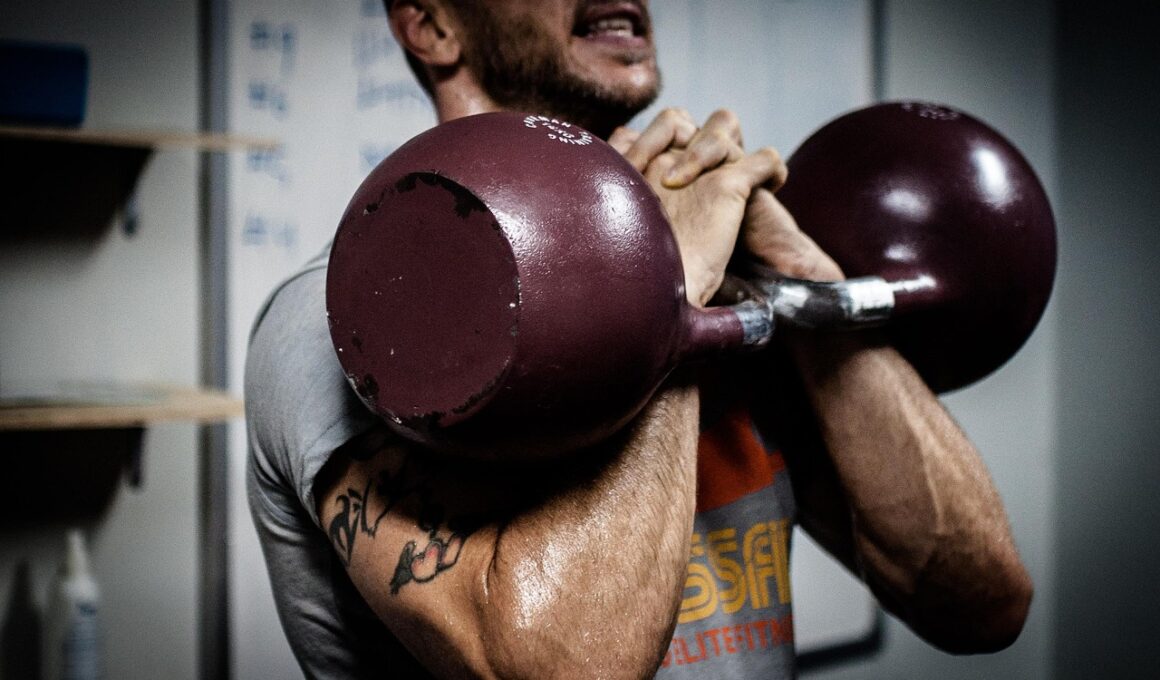Avoid These Mistakes to Improve Your Kettlebell Snatch
The kettlebell snatch is an incredible full-body exercise that can enhance strength, endurance, and explosive power. However, many beginners make common mistakes that impede their progress and increase the risk of injury. Understanding these mistakes is essential to achieving the desired results from your training. One common pitfall is neglecting proper warm-up protocols, which are vital for preparing your body and joints for dynamic movements. Without a proper warm-up, you may find yourself less mobile, thus limiting your ability to perform the snatch effectively. Additionally, inadequate warm-ups can lead to muscle strains or tears. Another common mistake is performing the movement too fast, sacrificing form for speed. It is crucial to focus on quality over quantity. Poor technique can cause overuse injuries or incorrect muscle engagement. Always consider your lifting mechanics such as grip, hip hinge, and breath control. Consistency and quality repetitions are critical, so take your time to perfect the snatch before trying to increase weight or speed.
Many individuals forget about the importance of engaging the core during kettlebell snatch lifts. Your core stabilizes the body during dynamic movements, ensuring that power is effectively transferred from your lower body through to the kettlebell. Engage your core by bracing it as if preparing for a punch. This activation provides stability at the shoulders and hips, which are both crucial points of energy transfer. Moreover, focusing on breathing is another aspect often overlooked by many. New lifters frequently hold their breath throughout the snatch, which leads to decreased oxygen supply and can result in shortness of breath or dizziness. Proper breathing helps maintain the rhythm of the movement and ensures fluidity in the execution. Remember to inhale before starting the lift, then exhale at the top of the movement. Weight distribution during the lift plays a vital role as well; ensuring you place weight towards the heels can help maintain balance and prevent injury. Lastly, different kettlebell sizes can impact your grip strength and lifting mechanics, so choose the right size based on your current skill and comfort.
Technique and Variation in Kettlebell Snatch
Employing the right technique in kettlebell snatch lifts is integral for maximizing efficacy while minimizing injury risks. One critical technical component is the swing phase prior to the snatch. This phase helps build momentum and sets up a smooth transition for the lift. Ensure your hips move explosively during this part of the exercise; aim for a vertical orientation as much as possible to avoid forward leaks in your lift. Many beginners initiate the lift too early, focusing too much on lifting and too little on swinging, which results in inefficient energy transfer. A strong back and proper shoulder alignment are also necessary during the pull phase. If your shoulders roll forward or lean back excessively, you create an imbalance that leads to injury. Experimenting with different kettlebell styles like competition or traditional can also affect performance. Competition kettlebells have a uniform size, while traditional ones usually vary along with the weight. Each offers unique benefits during training. Always ensure that your choice suits your lifting style and comfort to foster safer and effective movements.
Utilizing the proper grip is essential for successful kettlebell snatches. Newcomers often make the mistake of gripping the handle too tightly, leading to muscular fatigue during extended sets. Instead of a death grip, focus on a relaxed grip that allows the kettlebell to move fluidly during the exercise. A controlled grip enables better manipulation of the weight and reduces the risk of dropping it, enhancing overall execution. Another common mistake is not practicing proper locking out when finishing the snatch. It’s important to lock out the elbow at the top of the move; lack of this technique leads to excessive strain on the shoulder. Visualizing this lockout helps in maintaining overall shoulder health while increasing your lifting percentages. Furthermore, ensuring you have an adequate space to execute the snatch is crucial. Training in cramped or cluttered areas may disrupt fluid movement patterns. Always train where it is safe; keep the area clear of obstacles to help maintain proper lifting posture. Lastly, incorporating recovery techniques such as stretching and mobility work into your regimen can improve performance significantly.
Common Myths About Kettlebell Snatching
Aside from physical execution, various myths surround kettlebell snatch training that can misdirect beginners. A persistent belief is that kettlebell training is only for advanced lifters, limiting many newcomers from attempting it. However, the reality is that kettlebells can cater to all fitness levels. Modified versions of the snatch can still provide conditioning benefits for beginners. Always consult a fitness professional to help tailor movements based on experience and skill level. Some also believe that kettlebell training is strictly an upper-body exercise; this couldn’t be further from the truth. The snatch relies heavily on lower body strength and core stabilization. By honing these elements, you can minimize upper body fatigue while maximizing overall effectiveness. Another myth is that kettlebells alone sculpt your physique; using just one training tool will not lead to optimal results. A balanced fitness regimen, including various exercises such as bodyweight and aerobic activities, is crucial for achieving well-rounded fitness and health. Dismissing these misconceptions is key to mastering your kettlebell training.
Kettlebell snatching mistakes can also stem from a lack of planning in your training session. Beginners sometimes rush into workouts without establishing clear warm-up, practice, and cool-down strategies. Try to always incorporate an organized approach to your kettlebell sessions. Consider using a combination of strength warm-ups, mobility drills, and focused work on the snatch itself to develop comfort and familiarity. Not keeping a training log can also be a mistake; by recording your weights lifted, reps performed, and any adjustments made during workouts, you can tailor future sessions accordingly. Consistently tracking your journey helps identify patterns or areas needing improvement. Moreover, training with a partner can bring additional benefits. Training alongside someone more experienced can provide immediate feedback and encouragement. Having an accountability partner can also be a motivating factor for improvement. Lastly, setting short-term and long-term constructive goals can keep you focused. These goals will provide measurable markers for progress. Without goals, it is harder to assess performance, making it quite challenging to stay motivated.
Conclusion and Tips for Progress
To trot along a successful kettlebell snatch journey, it is essential to become aware of and avoid common mistakes that plague many beginner lifters. A deliberate focus on improving technique, awareness of your body mechanics, and maintaining a stable core will dramatically enhance your performance. Also, incorporating various kettlebell styles or working with others during workout sessions can provide necessary exposure to different methodologies. Consistent practice and feedback will only serve to improve efficiency and effectiveness. Remember to always keep workouts diverse; using kettlebells combines strength, conditioning, and explosiveness, providing multiple benefits for overall fitness. Along with technical execution, investing time in mobility work and strength training will support your overall goals. Lastly, don’t underestimate the importance of recovery; adequate rest and mobility work will enhance your ability to perform kettlebell snatches effectively. Utilize the feedback loop of training logs to review your past performance and make informed decisions for the future. Improving your kettlebell snatch requires time, patience, and dedication, so always commit to your fitness journey.
In summary, enhancing your kettlebell snatch involves a multi-pronged approach focused on technique, consistency, and understanding common mistakes. Recognize that mistakes are part of the learning curve. Addressing them effectively will set you up for a lifetime of kettlebell success and improved fitness.





